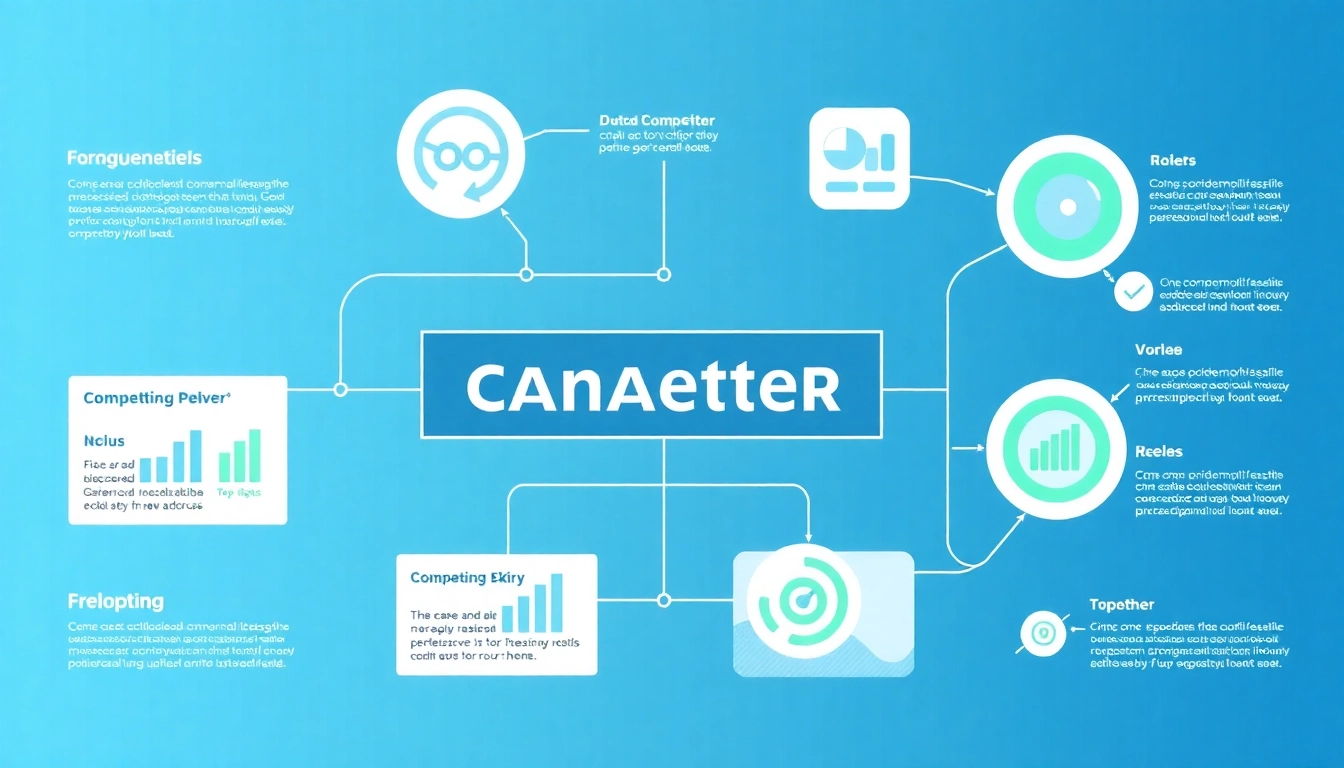Understanding Competitor Analysis
Definition and Importance
Competitor analysis, also known as competitive analysis, is the systematic exploration of similar brands within your industry to gain essential insights into their offerings, branding strategies, sales approaches, and marketing efforts. This critical process serves as a foundational component for businesses looking to carve out a niche in a highly competitive market. By competitor analysis, companies can identify their strengths and weaknesses relative to their competitors, ultimately developing strategies that leverage their unique selling propositions.
Types of Competitors
Understanding the different types of competitors is vital for an effective analysis. Competitors can typically be categorized into three main types:
- Direct Competitors: These are businesses offering the same products or services, targeting the same audience. An example could be two coffee shops located in close proximity to each other.
- Indirect Competitors: These businesses offer substitute products or services that meet similar customer needs. For instance, both coffee shops and tea houses may target caffeine consumers.
- Future Competitors: These are organizations that do not currently offer the same products or services but could enter the market based on trends or changes in consumer preference. For example, a bakery might become a direct competitor to coffee shops by starting to serve coffee.
Benefits for Businesses
Engaging in competitor analysis provides numerous benefits for businesses:
- Identifying Market Trends: By examining competitors, companies can discern trends in consumer behavior and preferences.
- Enhanced Strategic Planning: Insights gleaned from competitive analysis can inform business strategies, making them more robust and targeted.
- Opportunities for Differentiation: Understanding competitors’ weaknesses allows businesses to define and market their unique selling points more effectively.
- Improving Product Development: By analyzing the offerings of competitors, businesses can identify gaps in the market and innovate accordingly.
Steps to Conduct a Competitor Analysis
Identifying Competitors
The first step in competitor analysis is identifying your competitors. This should involve both direct and indirect competitors. Consider the following methods for effective identification:
- Market Research: Conduct thorough market research, utilizing tools like Google Trends to see who is gaining traction in your market.
- Customer Feedback: Assess what alternatives your customers have mentioned when discussing your products or services.
- Industry Reports: Review industry reports that analyze competitive landscapes to pinpoint relevant businesses.
- Social Media Analysis: Monitor social media discussions to identify which brands are being frequently mentioned in the context of your offerings.
Analyzing Competitor Offerings
After identifying competitors, the next step involves digging deep into their product and service offerings:
- Product Features: Examine what features and benefits their products or services include that resonate with the target markets.
- Pricing Strategies: Assess how their price points compare with yours and analyze how pricing models influence customer decisions.
- Customer Experience: Investigate how competitors deliver their products and services, including customer service quality and user experience.
- Brand Positioning: Determine how competitors position themselves in the market, including their value propositions.
Evaluating Marketing Strategies
Marketing strategies are pivotal to any business’s success. Analyzing how competitors market themselves can provide valuable insights:
- Digital Marketing Presence: Evaluate their website and social media presence for user engagement and content strategies.
- Content Marketing: Analyze the type of content they produce—blog posts, videos, infographics—and how effectively they drive audience engagement.
- Advertising Techniques: Consider the advertisements they use and which platforms they prioritize for their ads.
- Customer Engagement: Observe how they interact with their customers through social media and other channels.
Tools for Effective Competitive Analysis
Overview of Popular Tools
Several tools available today can facilitate an effective competitor analysis, helping businesses gather relevant data:
- SEMrush: A versatile tool that allows businesses to perform detailed SEO and competitor analysis.
- Ahrefs: Particularly useful for backlink and content analysis, helping to gauge a competitor’s online presence.
- BuzzSumo: An excellent resource for uncovering popular content and social media engagement surrounding competitor posts.
- SimilarWeb: Provides insights into website traffic and online behavior of competitors.
- SOCIALbakers: A social media analytics tool that helps track competitors’ social performance.
Choosing the Right Tool
Choosing the right tools for conducting competitor analysis depends on your specific needs:
- Define Objectives: Determine what you hope to achieve with your analysis. Different tools may excel in different areas.
- Budget Constraints: Consider your budget; some tools can be expensive, while others offer free trials or freemium options.
- User Friendliness: Select tools that your team can easily navigate to maximize their effectiveness.
Using Tools for Data Gathering
Once you have selected the relevant tools, here’s how to systematically gather data:
- Set Up Monitoring: Use tools like Google Alerts to get alerts about competitors’ activities and industry news.
- Benchmarking: Use metrics from your tools to compare critical performance indicators against your competitors.
- Surveys and Feedback: Engage with your audience to validate findings from your analysis and gather additional insights.
Best Practices for Competitor Analysis
Regular Updating of Data
Competitive analysis should not be a one-time effort. Instead, it should be an ongoing process:
- Schedule Regular Reviews: Set a schedule for regularly updating your competitor data to capture changes in strategies.
- Adapt to Market Changes: Stay attuned to shifts in market dynamics that may warrant a reevaluation of competitive standings.
Integrating Insights into Your Strategy
The insights gathered from competitor analysis must translate into actionable strategies. Consider these steps:
- Adjust Marketing Tactics: Implement changes to your marketing efforts based on insights derived from competitor campaigns.
- Refine Product Development: Use feedback to adapt offerings and address market gaps identified during the analysis.
- Employee Training: Share insights with teams to empower them in their respective roles, ensuring that the whole organization benefits from the analysis.
Avoiding Common Pitfalls
There are several common pitfalls businesses encounter while conducting competitor analysis:
- Overlooking Smaller Competitors: Don’t just focus on industry giants; smaller competitors may have innovative strategies that can offer valuable lessons.
- Confirmation Bias: Avoid filtering information to only confirm what you believe. Consider contrary insights to gain a fuller picture.
- Ignoring Data Context: Always interpret gathered data within the context of your specific business and industry nuances.
Case Studies in Competitor Analysis
Successful Implementations
Learning from real-world examples can provide insight into best practices in competitor analysis:
Case Study: Starbucks vs. Dunkin’ Donuts
Starbucks has long been recognized for its premium coffee and customer experience. By conducting extensive competitor analysis, Starbucks observed Dunkin’ Donuts’ aggressive pricing and value-focused strategy. In response, it launched the “Happy Hour” promotion, delivering added value through well-timed discounts, thereby enhancing customer engagement and loyalty.
Lessons Learned from Failures
On the other hand, failures can teach hard but crucial lessons:
Case Study: Blockbuster vs. Netflix
Blockbuster is a classic example of a company that failed to adapt to competitive analyses of technological advances in home entertainment. While Netflix was initially a DVD rental service, competitor analysis showed the rise of online streaming. Blockbuster ignored these insights, leading to its eventual decline, showcasing the importance of agility in competitive strategies.
Future Trends in Competitive Analysis
The landscape of competitive analysis is constantly evolving, influenced by emerging technologies and market dynamics:
- AI and Machine Learning: The increasing use of AI in data analysis will allow businesses to predict trends more accurately and respond proactively.
- Real-Time Analytics: As the necessity for immediate data grows, tools capable of providing real-time competitor analytics will become increasingly valuable.
- Increased Focus on Customer Experience: Future analysis will heavily weigh customer reviews and experiences, understanding that brand loyalty is rooted in satisfaction.



